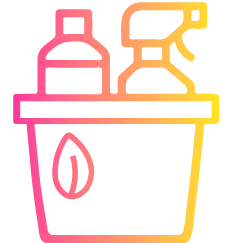The UC Office of the President (UCOP) is the systemwide headquarters of the University of California that manages UC’s fiscal and business operations and supports the academic and research missions across its campuses, labs and academic health centers. UCOP owns and leases spaces primarily in California, but also has properties in Washington, D.C., and Mexico City.
In 2022, many UCOP staff returned to their offices, although they kept hybrid working arrangements, impacting many sustainability metrics, such as greenhouse gas emissions and per capita potable water use.
The UC Path facility in Riverside began receiving the entirety of its electricity from solar energy infrastructure, the downtown Oakland Franklin location renovated its building ventilation system to reduce dependence on natural gas, and the new leased Broadway location in Oakland received LEED Commercial Interiors Gold certification. UCOP’s potable water use increased by about 31% compared to the previous fiscal year, reflecting staff returning to the office. UCOP’s waste generation also increased, although its overall waste diversion rate is now slightly higher than pre-pandemic levels, at about 56% when including construction and demolition waste.
In 2022, UCOP also invited employees into a new strategic planning process by hosting two equity-centered climate resilience workshops geared to preparing for the impacts of climate change.

CLIMATE PROTECTION – EMISSIONS
2021 data will be finalized after verification by a third party by early 2023.
UCOP saw a significant decrease in scopes 1, 2, and 3 emissions in 2021. This can largely be attributed to UCOP employees working remotely during the pandemic. Fuel, electricity and travel-related emissions all dropped significantly. For example, air travel was minimal as most internal and systemwide events were conducted virtually. Additionally, energy efficiency projects, such as the HVAC optimization project at 1111 Franklin St., reduced the amount of natural gas needed to heat and cool the building.
ENERGY – RENEWABLE energy use
ENERGY USE INTENSITY (EUI)
UCOP saw a decrease in its EUI in the calendar year 2021.
Green building
UCOP received a LEED v4 Gold certification for Commercial Interiors for the build-out of a new leased space in downtown Oakland. It received full or nearly full credit for enhanced commissioning, optimized energy performance, construction and demolition waste management, low-emitting materials, a construction indoor air quality management plan, quality views, access to quality transit, and surrounding density and diverse uses.
1 Platinum, 2 Gold and 2 Silver
Total number of LEED certifications
procurement

green spend on electronics (71%)

green spend on cleaning supplies (58%)

green spend on indoor office furniture (99%)

green spend on office supplies (41%)
The University resumed reporting on green spend, as defined in the Sustainable Procurement Guidelines, in fiscal year 2021–22 and reached out to suppliers for spend data in four product categories for this year’s report.
Green spend is defined as meeting preferred or minimum criteria in UC’s Sustainable Procurement Guidelines.
Suppliers reporting: Electronics (6), Furniture (2), Cleaning supplies (2), Office supplies (1).
UC Systemwide Spend Analytics category data provided by CalUSource.
Transportation
The ongoing pandemic and changes in operations made calculating commute modes for UCOP locations challenging this year. However, telecommuting remained the primary commute mode for the 2021–22 fiscal year reporting period. As employees returned to work, the telecommute rate was estimated at 86%, significantly above pre-pandemic levels. As staff return to work, hybrid work schedules are expected to continue to reduce the need for single-occupancy-vehicle commute trips. Additionally, UCOP offices reported eight EV charging stations, with recent additions at UC Path, Broadway and Franklin.

of employees are utilizing alternative commuting methods

EV charging ports
WATER
*Based on a 3-year average of fiscal years 2005-08.
UCOP’s total potable water consumption increased by about 31%, from 5.5 million gallons to 7.6 million gallons. This change resulted from increases in the number of employees working on-site as well as a leak detected in the Franklin building. Additional factors impacting UCOP data was the discovery of a potable water meter change at UC Path and the inclusions of the newly onboarded Broadway building.
ZERO WASTE – GENERATION
*These numbers might include a small amount of incineration that is being phased out.
Per capita waste generation increased to 2.2 pounds per person per year. These changes are the result of an increase in the number of employees working on-site and a change in building reporting boundaries. The decline in waste generation during fiscal year 2020–21 is due to the pandemic-related closure of UCOP facilities.
ZERO WASTE – DIVERsion
UCOP offices reported an estimated diversion rate of 56%, whether construction and demolition waste is included or not, which is a small increase from last year’s rate of 53%. These changes are the result of an increase in the number of employees working on-site, a change in building reporting boundaries and construction projects, which contribute to overall diversion but not per capita waste generation.
 Sustainability Annual Report 2022
Sustainability Annual Report 2022
